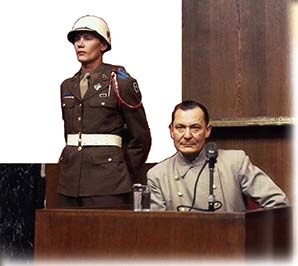SECTION 5: Effects of the War

▲ Defendant Hermann Goring (right) at the Nuremberg Trials
WITNESS HISTORY  AUDIO
AUDIO
Nazism on Trial
In October 1945, a historic trial unlike any other began. The 21 defendants were the cream of the Third Reich, leaders of Hitler’s war machine and architects of the Holocaust. Robert Jackson, the American prosecutor, scoffed as men like Hermann Goring, Hitler’s handpicked successor, claimed to be tools of Hitler, unaware of his true plans. In his closing speech, Jackson turned the spotlight not on the defendants alone, but on the future of humanity:
“No half-century ever witnessed slaughter on such a scale, such cruelties and inhumanities…. If we cannot eliminate the causes and prevent the repetition of these barbaric events, it is not an irresponsible prophecy to say that this twentieth century may yet succeed in bringing the doom of civilization.”
—Robert Jackson, closing speech, Nuremberg War Crimes Trials, 1946
Objectives
- Evaluate the goals that Allied leaders set for the postwar world.
- Describe the steps that the United States and other nations took toward international cooperation.
- Explain the impact of World War II on the postwar United States.
Terms and People
- Yalta Conference
- superpower
- GATT
- United Nation
- Universal Declaration of Human Rights
- Geneva Convention
- Nuremberg Trials
NoteTaking
Reading Skill: Understand Effects As you read, look for various developments in the postwar world that resulted from World War II.
Why It Matters World War II changed the nation in profound ways. Many Americans came home determined to extend the ideals of democracy and freedom at home as well as abroad. In addition, the United States emerged from the war prepared to take on the complex and vital role in world affairs that it still holds today. Section Focus Question: What were the major immediate and long-term effects of World War II?
Allies Set Postwar Goals
World War II differed from World War I in several ways. One major difference was that it was fought to the bitter end. In 1918, the Kaiser had surrendered before the Allies could invade Germany. By contrast, in World War II, Japan and Germany kept fighting long after their defeat was certain. In the last year of the war, they lost battle after battle, retreated from the lands they had conquered, and saw the slow destruction of their military forces. Allied bombing devastated their cities and industries. Yet Germany fought on until Hitler committed suicide, and Japan refused to surrender until after the bombing of Hiroshima and Nagasaki.
Allies Make Plans at Yalta
The protracted fighting gave the Allies time to make plans for a postwar world. Roosevelt, Churchill, and Stalin met at Yalta on the Black Sea in February 1945 to discuss final strategy and crucial questions concerning postwar Germany, Eastern Europe, and Asia. At the Yalta Conference, the Big Three agreed that Poland, Bulgaria, and Romania would hold free elections. However, Stalin later reneged on this promise.





